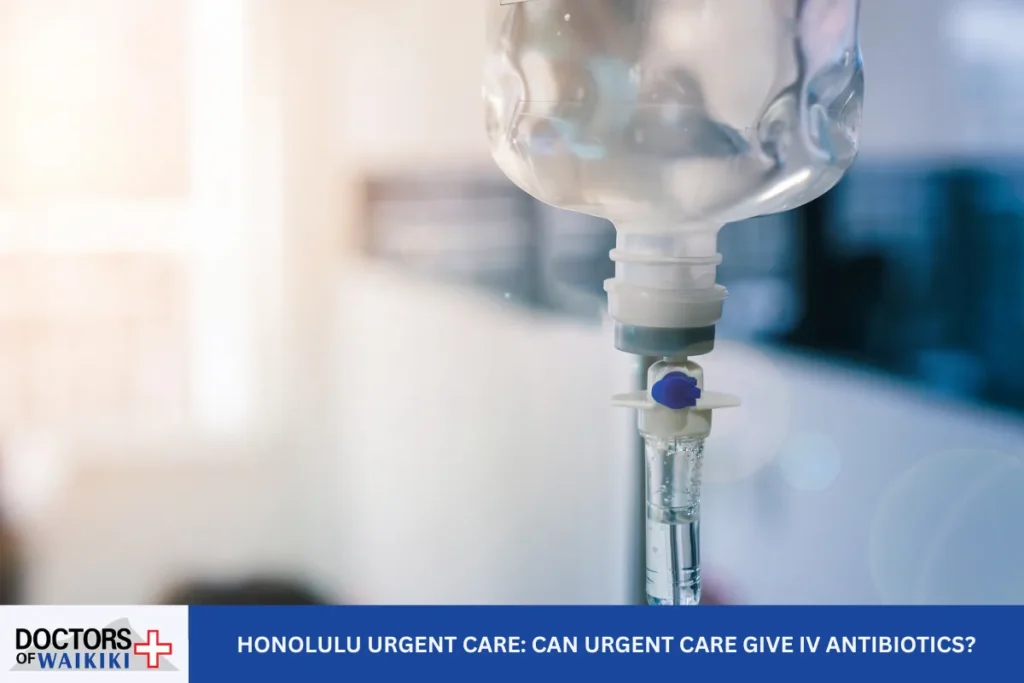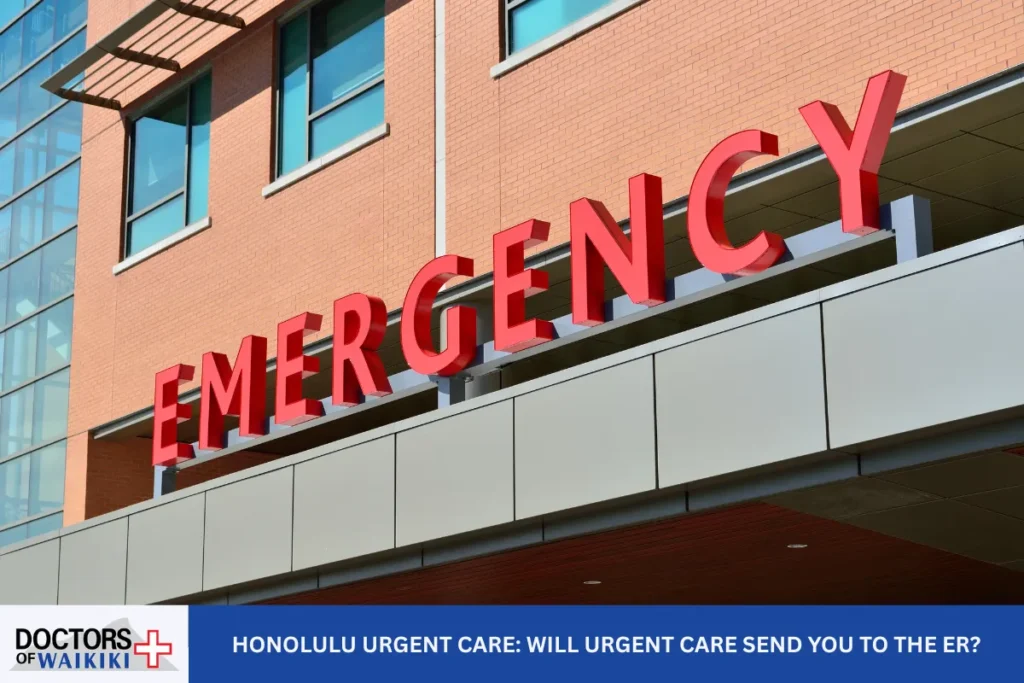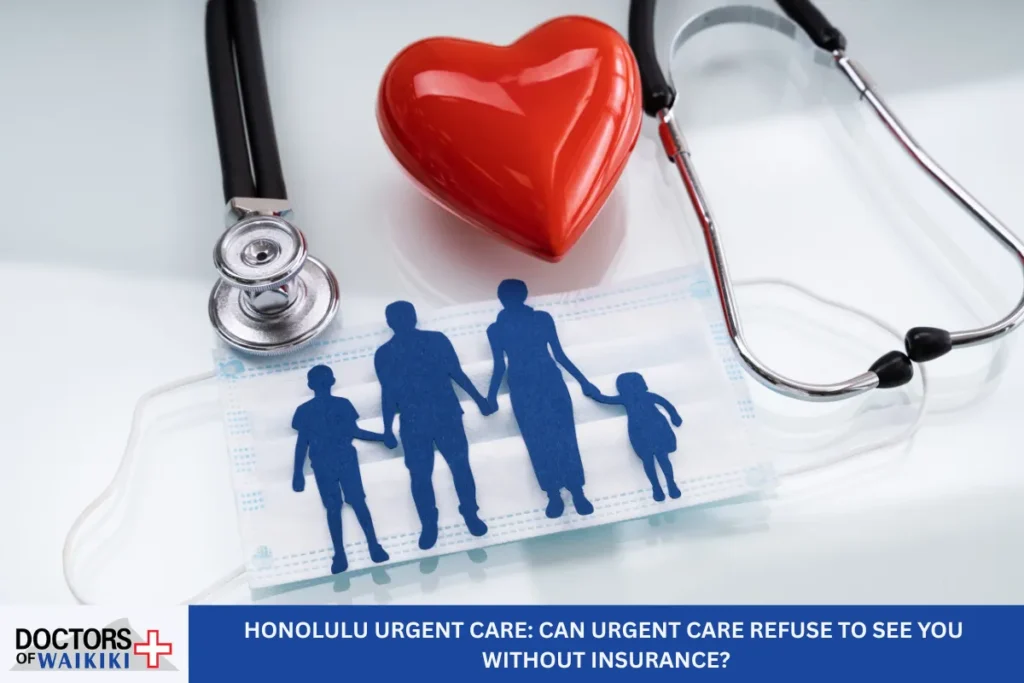Are you searching for prompt relief from a bacterial infection and wondering, “Can Honolulu urgent care give IV antibiotics?” If you’ve ever been sick enough to consider a walk-in clinic, but aren’t sure if you need the emergency room, you’re not alone. Many patients worry about waiting in long lines at hospitals or paying high costs for care, especially if they’re uninsured or their symptoms are serious enough they need immediate medical attention. This article will clear up confusion, explain when an urgent care center can help with intravenous antibiotics, and help you decide the safest, quickest, and most affordable route to feeling better right away.
Urgent Care Centers: A Key Player in Modern Health Care

Urgent care clinics and walk-in clinics are designed for people with non-life-threatening injuries and illnesses that need fast treatment but aren’t severe enough for emergency room visits. Board-certified doctors, nurse practitioners, physician assistants, and other medical professionals provide care for a wide range of conditions—from sore throats and sinus infections to pink eye and urinary tract infection. Honolulu urgent care facilities, like Doctors of Waikiki, offer walk-in availability, electronic medical records, advanced laboratories, diagnostic imaging technology (such as on-site X-ray and ultrasound), and sometimes even radiology services.
Many urgent care centers in Oahu, Hawaii operate with extended hours or even 24 hours, making them reliable for those who need same-day or after-work care. They accept most health insurance coverage, self-pay, and even uninsured patients, helping make patient-centered services available to all.
IV Antibiotics in Urgent Care: What You Need to Know

Can an Urgent Care Clinic Give IV Antibiotics?
The short answer is yes—some urgent care options in Honolulu can provide intravenous antibiotics, but not every urgent care center does this routinely. Intravenous antibiotics or “IV antibiotics” involve delivering medicine directly into your bloodstream for quick and powerful action against bacterial infections. Medical personnel may recommend this treatment plan if oral antibiotics aren’t effective, you cannot swallow pills due to vomiting, or your infection is moderate but not requiring hospitalization.
When Is IV Therapy Appropriate in Urgent Care?
IV antibiotics are ideal for moderate infections that are not serious enough for emergency medical care or a hospital stay. They work right away and are especially helpful if:
- The patient is not tolerating oral medications due to severe nausea or vomiting.
- The infection is progressing or hasn’t improved with oral medication (failing oral antibiotics).
- The specific infection requires a potent, fast-acting antibiotic (like a ceftriaxone shot, cefazolin, or ampicillin-sulbactam).
- Abscesses, cellulitis, some wound infections, and certain urinary tract infections (including pyelonephritis) can sometimes be treated with intravenous or IM (intramuscular) antibiotics in a walk-in clinic.
The most common medications administered include ceftriaxone, vancomycin, and sometimes ertapenem, depending on local antibiotic stewardship program and policy on antibiotic-resistant bacteria.
Top Conditions Treated with IV Antibiotics at Urgent Care
Urgent care clinics are increasingly offering infusion therapy for certain types of bacterial infection. Here are the infections and situations often considered:
- Skin and Soft Tissue Infections (SSTI): Cellulitis, abscesses, diabetic foot infection, MRSA (methicillin-resistant Staphylococcus aureus)
- Urinary Tract Infections (complicated or pyelonephritis)
- Wound Infections: Especially with redness or pus after surgery (post-surgical infections)
- Septic Arthritis: Joint infections that need quick response, though hospital care might still be preferred for severe cases
- Pneumonia: In some cases where symptoms are not severe, especially for those failing oral antibiotics
- Other Infections: Such as certain middle ear infections, or rare cases of whooping cough
The attending health professional will conduct exams and decide if IV placement is needed or if IM antibiotics (antibiotic injection) are more suitable.
The Difference: Urgent Care Center vs Emergency Room for IV Antibiotics

It is important to know when to choose an urgent care center and when you need the emergency department for IV antibiotics. Here’s how to decide:
When Can Urgent Care Handle IV Antibiotic Needs?
- Mild to Moderate Severity: You have an infection that is uncomfortable, worsening, or not improving with oral medication, but you are not experiencing life-threatening symptoms.
- You’re Otherwise Stable: No severe pain, no high fever (over 103°F), normal blood pressure, and you can keep down fluids.
- Walk-in Convenience: You need treatment today without the wait or cost of an ER visit.
When Should You Go to the ER Instead?
If you have any of the following red-flag symptoms, urgent care will likely refer you for emergency services or escalate care to the hospital:
- Confusion or altered mental status
- Low blood pressure (hypotension)
- Shortness of breath/hypoxia (oxygen saturation low)
- Rapidly spreading skin redness/pain (suggestive of sepsis)
- Severe pain or inability to move a limb
- High fever with rigors or chills
- Severe dehydration or intractable vomiting
- Head trauma, heart attack, or serious orthopedic injuries
If your symptoms could represent a life-threatening health issue, never wait—go directly to the emergency room.
Read Honolulu Urgent Care: Can Urgent Care Refuse to See You Without Insurance?
How Urgent Care Decides on IV Antibiotics: Policies and Clinical Decisions
Evaluation and Monitoring
Medical teams including board-certified physicians, physician assistants, nurse practitioners, and support staff follow best practices to decide on the right treatment. Here’s what happens:
- Triage and Assessment: Patient’s vital signs, review of medical history, and physical exam are performed right away.
- Medical Tests: Point-of-care tests like CBC (complete blood count), CMP (comprehensive metabolic panel), cultures (wound, blood, or urine), and diagnostic imaging (on-site X-ray, ultrasound) may be used.
- Diagnosis: Lab tests help distinguish between bacterial infection (which responds to antibiotics) and viral illnesses (which do not).
- Treatment Plan: If needed, IV placement is done, and antibiotics are administered.
- Monitoring: The medical provider observes the patient for side effects or reactions and makes sure improvement is seen.
- Discharge and Follow-up: Clear instructions, prescriptions, and referrals for primary care physician or outpatient infusion services as needed.
Outpatient Infusion Services and Ambulatory IV Therapy
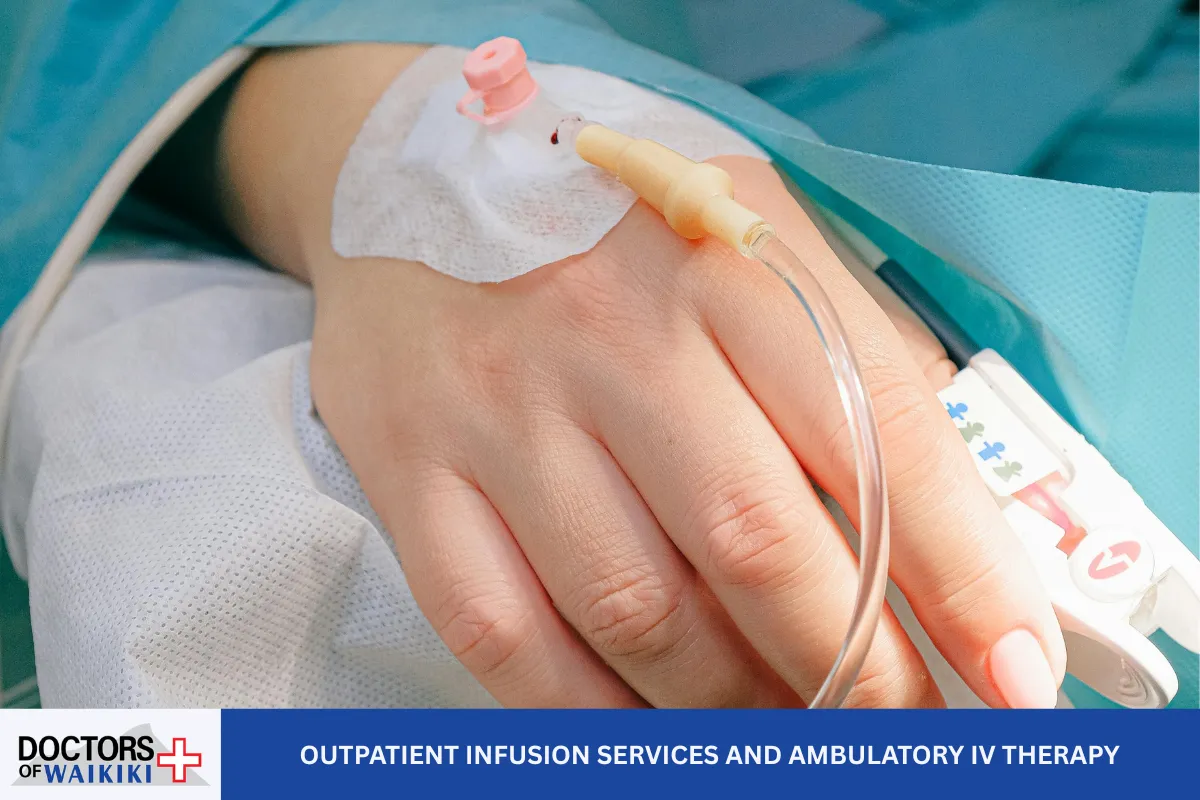
Honolulu’s urgent care centers sometimes coordinate with local infusion centers or provide on-site IV therapy (sometimes called OPAT—outpatient parenteral antimicrobial therapy). Outpatient IV antibiotic therapy allows suitable patients to receive multi-day antibiotics without being hospitalized.
- Who Qualifies?
- Patients well enough to go home after each treatment.
- No severe or rapidly worsening symptoms.
- Infections responding to treatment or after finishing a full course in the hospital.
- How Is It Given?
- Through a peripheral IV for single or a few doses.
- Via a PICC line (peripherally inserted central catheter) for long-term needs.
- What About Monitoring?
- Regular follow-up is needed for lab tests and to watch for side effects.
- If the situation worsens, escalation to hospital may be required.
Outpatient infusion therapy can be especially helpful for those wishing to avoid hospitalization, control costs, and minimize disruption to work or family.
Antibiotic Stewardship and Safety in Urgent Care Settings
Urgent care clinics adhere to strict policies to prevent antibiotic resistance and promote appropriate use. This means:
- Only giving antibiotics for confirmed or strongly suspected bacterial infections (not viral infection).
- Choosing antibiotics based on best medical training and current guidelines.
- Completing the full course of treatment to prevent relapse or antibiotic-resistant germs.
- Following the antibiotic stewardship program for the region.
- Using IM/IV therapy responsibly and only when indicated.
Antibiotics are powerful. Overuse can lead to antibiotic-resistant bacteria, making future infections harder to treat. That’s why medical personnel carefully evaluate your symptoms and lab test results.
Prescription vs Administration: Other Considerations
- Can Urgent Care Centers Prescribe Antibiotics?
Yes, urgent care clinics routinely prescribe oral antibiotics for ear infections, strep throat, urinary tract infection, bronchitis, and other common illnesses after doing appropriate evaluation (sometimes including a rapid strep test or other diagnostics).
- Can Urgent Care Give IV Antibiotics or IM Injections?
Many urgent care clinics, including those in Honolulu and Waikiki, are equipped to administer both IV and IM antibiotics for eligible patients with moderate infections.
- Are There Limitations?
Not all clinics have infusion pumps, on-site lab tests, advanced diagnostic imaging, and specialists needed for severe or complex cases. If you need a full IV drip for a prolonged period, a hospital or specialized outpatient infusion center may be necessary.
- What About Costs and Coverage?
Most urgent care clinics accept insurance, require a copay, and have self-pay pricing for uninsured patients. This makes them much more affordable than the ER for non-life-threatening health issues. Always bring your insurance card for quickest registration.
Walk-In Urgent Care Clinics Versus Other Providers: Making the Right Choice
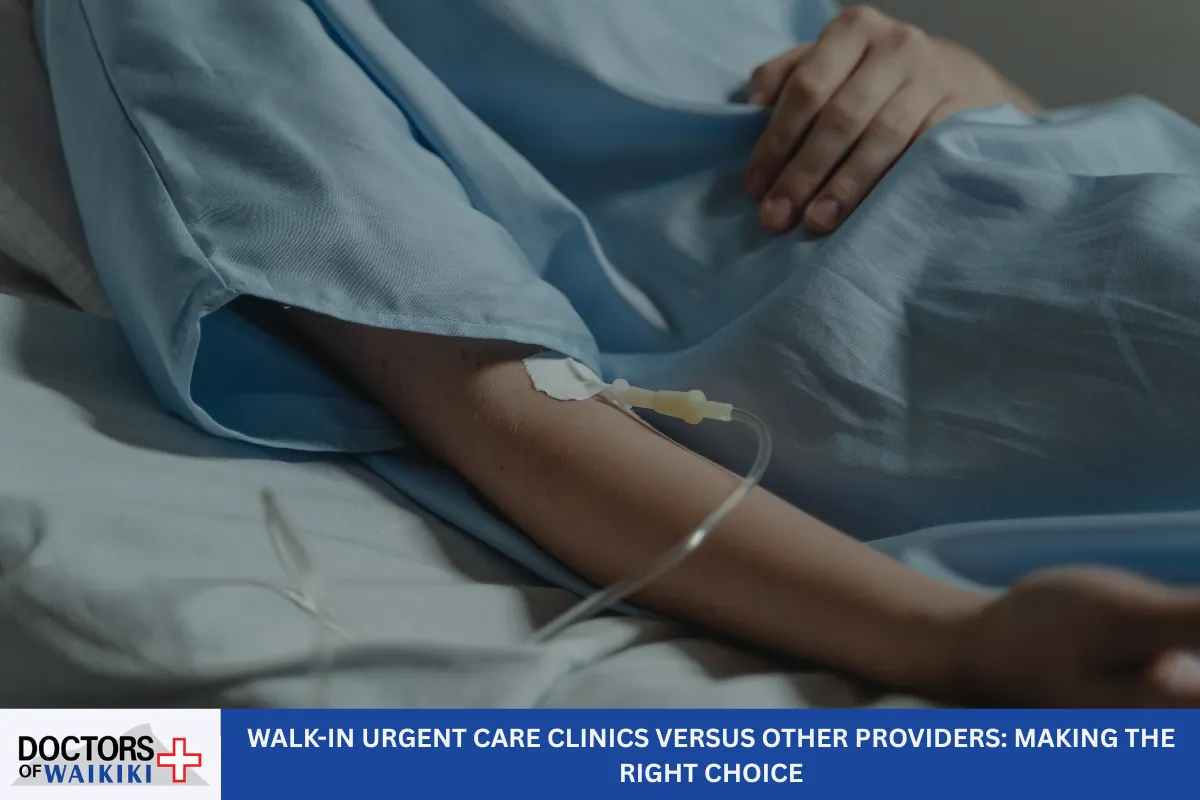
Let’s compare your options in a medical situation where antibiotics are needed:
Primary Care
See your primary care physician for ongoing care, chronic diseases, and preventative healthcare. You’ll need an appointment, and not all clinics offer IV therapy.
Emergency Room
Go to the ER for emergency medical care—severe infections, heart attack, severe bleeding, chest pain, head injury, or serious accidents. ERs have 24 hours advanced laboratories, full imaging studies (CT scan, MRI), and access to specialists.
Urgent Care Center
Perfect for walk-in visits, minor illnesses and injuries, and infections that are serious but not dangerous. Urgent care clinics offer fast access, lower waiting times, and high-quality care—often with less cost and hassle.
Services Beyond Antibiotic Therapy
Honolulu urgent care centers provide much more than infection treatment. Here’s a quick list of other urgent care services:
- Immunizations (flu shots, COVID-19 vaccines, tetanus toxoid, hepatitis B vaccine)
- Physical exams, sports physicals, and work and school clearance
- Occupational health and travel medicine, including occupational health services
- Advanced diagnostic testing (blood test, laboratory services, on-site X-ray)
- Pain management (pain clinic), women’s health services, men’s health, and pediatric care
- Chronic disease support, mental health support, orthopedic care, orthopedic injury walk-in clinic
- COVID testing, flu season treatments, and virtual urgent care
- Platelet-rich plasma injections for sports injuries
- Imaging studies with radiology services
- Emergency care instructions for non-life-threatening health issues
With so many options, urgent care clinics bridge the gap between primary care and emergency room care.
When to Visit Urgent Care for IV Antibiotics in Honolulu
You should consider a Honolulu urgent care clinic if:
- You have a moderate infection and need antibiotics right away but don’t have signs of severe illness.
- You are unable to swallow or tolerate oral antibiotics due to vomiting or GI upset.
- Your infection isn’t improving or is worsening despite a full course of oral medicine.
- You want a same-day evaluation, on-site labs, and IV therapy in a convenient setting.
- You want an assessment to rule out more serious problems that could require referral.
Always check ahead for walk-in availability, patient volumes, and wait times to avoid a long waiting line.
Honolulu Urgent Care – Doctors of Waikiki
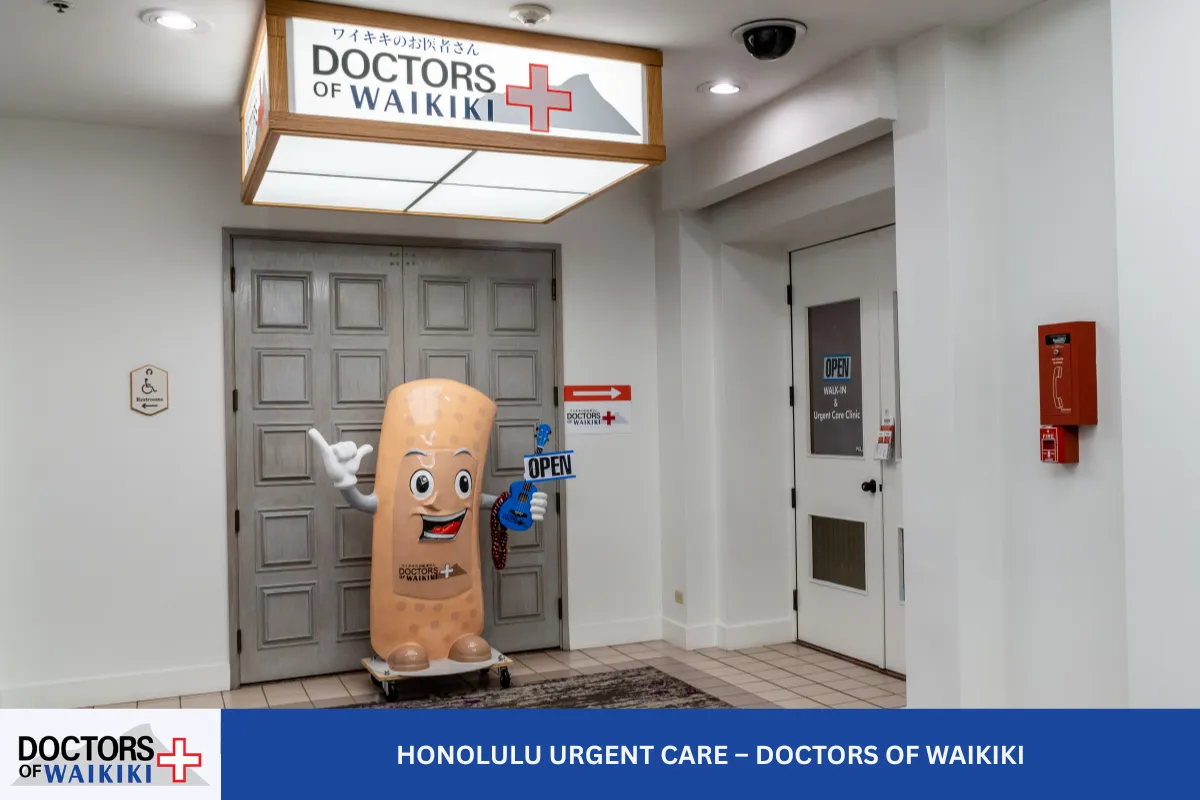
Searching for fast, effective treatment for infections in Honolulu? Doctors of Waikiki provides top-tier Honolulu urgent care, including IV antibiotic therapy for moderate infections like cellulitis, urinary tract infections, and more. Skip the long ER waits and high costs—our expert team offers walk-in convenience, same-day labs, and safe administration of both IV and IM antibiotics. We help you recover quickly when oral medications aren’t enough, all in a caring and supportive environment. Whether you’re insured or self-pay, you’ll find affordable care and answers to your health questions at Doctors of Waikiki.
Call us today at (808) 922-2112 to schedule a consultation and experience prompt, affordable urgent care solutions. We proudly serve Honolulu, Hawaii!
Frequently Asked Questions
1. How do I know if my infection needs IV antibiotics instead of oral antibiotics?
Not all infections require IV antibiotics. IV antibiotics are necessary when an infection is moderate or severe, not responding to oral therapy, or when you can’t swallow or absorb oral medications (due to vomiting, severe nausea, or gut conditions). Common examples include some cellulitis, severe urinary tract infections, and certain pneumonia cases. The medical team at a Honolulu urgent care center evaluates your symptoms, performs testing, and checks medical history to recommend the safest and most effective treatment plan. Oral antibiotics are usually tried first for mild infections, but IV therapy will be considered for those needing quick, strong medication action or after failing oral treatment.
2. Will my insurance cover IV antibiotic treatment at an urgent care center?
Most health insurance plans do cover urgent care visits, including IV antibiotic therapy, especially when a healthcare provider deems it medically necessary. You’ll need your insurance card at the time of your visit, and there may be a copay or coinsurance required. For uninsured patients, self-pay options are available at set prices, which are typically much lower than hospital or ER costs. If you need multi-day outpatient IV antibiotics (OPAT), ask about follow-up costs and insurance authorization. Checking with the clinic and your insurer ahead of time ensures no surprises when seeking care.
3. If my symptoms worsen after receiving IV antibiotics at urgent care, what should I do?
If your symptoms get worse, such as persistent high fever, confusion, severe pain, shortness of breath, dizziness, or new swelling/redness spreading rapidly, you should seek emergency care right away. Urgent care clinics provide emergency care instructions and are trained to recognize when a condition needs higher-level care at a hospital. Never hesitate to return or to go to the emergency room if you feel worse or aren’t improving. Good urgent care centers will also schedule follow-up or coordinate with your primary care doctor or infusion center as needed.
4. Are the staff at Honolulu urgent care clinics trained to handle IV therapy safely?
Yes, Honolulu urgent care clinics employ board-certified physicians, nurse practitioners, physician assistants, advanced practice providers, and licensed support staff well-versed in infusions, IV placement, and monitoring for side effects. Most reputable urgent care facilities offer continuous staff education and follow protocols suited for infusion therapy, with backup arrangements for referral if necessary. Staff also participate in antibiotic stewardship programs to ensure appropriate, safe use of antibiotics. Medical teams work closely with specialists and hospitals to streamline care if a patient needs escalation.
5. What is the difference between IM (intramuscular) and IV (intravenous) antibiotics, and can both be given at urgent care?
IM antibiotics (such as a ceftriaxone shot) are injected directly into a muscle, while IV antibiotics are given straight into the bloodstream via a vein. IM shots are common for certain infections that don’t require a full IV drip—it’s a quick, single-dose treatment that’s ideal in some urgent care scenarios. IV therapy allows constant dosing and rapid effect, best for more severe infections or those who need ongoing treatment. Most urgent care clinics in Honolulu are equipped to administer both IM and IV antibiotics, choosing the route that best fits the medical situation and ensuring rapid recovery.

